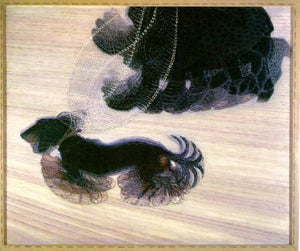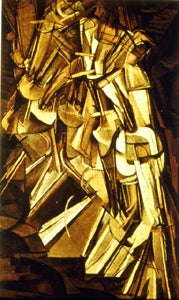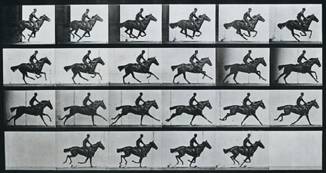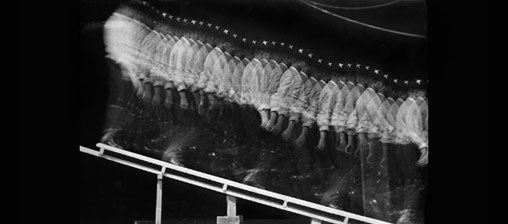In the twentieth century, whole movements centered on motion and time. The work of the Futurists, for example, conveyed the velocity of a new industrial age as well as a political point of view through the use of multiple, overlapping images within a single frame. Marcel Duchamp also utilized a similar technique in his famous Nude Descending a Staircase.
It has been suggested that works like these would not have been possible without the efforts of researchers such as Etienne-Jules Marey in France and Eadweard Muybridge of the United States and Great Britain (note: unconventional spelling of "Edward" is correct). Both of these men pioneered the use of multi-image works as an aid to understanding human anatomy and animal locomotion. Eadweard Muybridge Muybridge's name today is associated primarily with the photography of movement. He first became involved in this field in 1872 when Leland Stanford, former Governor of California, asked him to photograph his famous horse, Occident. There was much controversy in horse racing circles at the time as to whether a trotting horse ever had all four feet off the ground at any one point in time. Cameras were placed in a line in a long shed and in front of each was a special shutter triggered electro-magnetically by the horse or the wheels of a sulky as it made contact with wires stretched across the track. The method was successful in achieving the first photographs of sequences of movement and the results were published in Muybridge's Attitudes of Animals in Motion (1881). http://www.kingston.ac.uk/Muybridge/muytext4.htm
Eadweard Muybridge, The Galloping Horse Portfolio, 1887 Explore the speeds at which different media display images from the Galloping Horse Portfolio in the Interactive Module on Frame Rate. For more links to the work of Eadweard Muybridge, click on: http://www.artcyclopedia.com/artists/muybridge_eadweard.html Etienne-Jules Marey Born in 1830, the French physician and physiologist Etienne-Jules Marey became interested in movement at an early stage of his career: the movement of blood as it circulated, the movements which controlled the beating of the heart, then those of the muscles and nerves. To improve his studies, he developed more and more precise recording instruments. Once he had explained the internal movements of the body, Marey extended his investigations to the motion of the body as a whole: a walking human being, a flying dragonfly, a swimming ray, a falling cat...All these movements were described in space and time by his graphical method, and then by chronophotography, his invention which opened the way for the cinematograph which was to be "born" at the end of the nineteenth century. In the image below, note the striking similarities between Marey's early motion studies of a figure descending an inclined plane and Marcel Duchamp's Nude Descending a Staircase (previous section).
Etienne-Jules Marey, Descent of Inclined Plane, c. 1882, Chronophotograph For more information on Etienne-Jules Marey see the excellent website at: http://www.expo-marey.com/ANGLAIS/home.html
|















